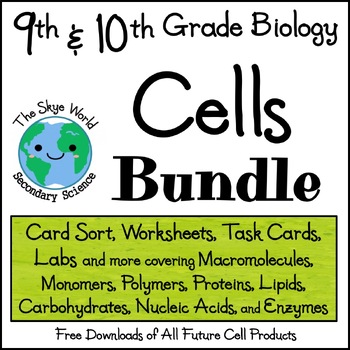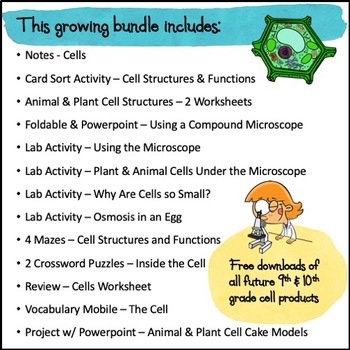Bundle of Lessons - Plant & Animal Cell Structures and Functions
- Zip
- Easel Activity
Products in this Bundle (14)
showing 1-5 of 14 products
Description
In this growing bundle of lessons on cells, students will learn the structures and functions of plant and animal cells. This bundle will also prepare 7th grade science and biology students on the topics of prokaryotes, eukaryotes, organelles, microscope use, active and passive transport, osmosis, cell membranes, and size vs volume. Bundle includes notes, card sorts, lab activities, mazes, crossword puzzles, project, worksheets, digital versions, distance learning, and more! Great for homeschoolers, too.
Important Information
- Answer keys included
- Includes activities recommended for 7th grade science and 9th & 10th grade biology
Included in this bundle – click to see details
- Notes – Cells
- Card Sort Activity - Cell Structures and Functions
- Animal & Plant Cell Structures and Functions – 2 Worksheets
- Foldable Worksheet – Microscope Parts & Functions
- Lab Activity – Using the Microscope
- Lab Activity – Plant and Animal Cells Under the Microscope
- Lab Activity – Why Are Cells So Small?
- Lab Activity – Osmosis in an Egg
- Plant and Animal Cell Structures and Functions Maze Activities - 4 mazes
- Crossword Puzzles – Inside the Cell Part 1 and 2
- Review - Cell Structures and Functions Worksheet
- Vocabulary Mobile – The Cell
- Animal and Plant Cell Cake Project - Rubric with Powerpoint Instructions
- Cell Structures + Functions Digital + Printable Task Cards
TEKS Covered
7.4A, 7.3B, 7.12C, 7.12D, 7.12E - middle school science
B.1A, B.1B, B.2E, B.2F, B.2G, B.2H – LAB ACTIVITIES
B.3F - history of biology
B.4A - prokaryotic and eukaryotic cell structures and functions
B.4B - cellular processes - homeostasis and transport
B.4C- virus structure, reproduction, and role in disease
NGSS Standards Covered
MS-LS1-1, MS-LS1-2, MS-LS1-3
HS-LS1-2, HS-LS1-4
Related Resources
- 9th and 10th Grade Biology Growing Bundle of Lessons
- Bundle of Lessons – Classical Genetics
- Bundle of Lessons – Molecular Genetics
- Bundle of Lessons – Photosynthesis and Cellular Respiration
- Bundle of Lessons - Biochemistry
Acknowledgements
Thank you to the following artists for the wonderful clipart used throughout this unit. Just click on their shop name to go directly to their stores:
- Ron Leishman’s Digital Toonage
- Clipartino
- Sarah Pecorina Illustration
- Artifex
- The Cher Room
- Krista Walden – Creative Clips
- Lovely Jubblies Teach
- Hidesy’s Clipart
- Creating for the Classroom
Terms of Use – copyright ©Catherine Skye All rights to this product are reserved by author. This authorizes one teacher to use this product. If you want to share it with other teachers, please purchase a license to share this work. Copying by more than one teacher, classroom, department, school, or school system is prohibited UNLESS you purchase a license. Clipart and elements found in this PDF and others on my site are from the public domain unless otherwise noted. All products on my site are intended for classroom and personal use and may not be digitally copied for reuse in any form. Any misuse is considered copyright infringement and violates the DMCA (Digital Millennium Copyright Act).





